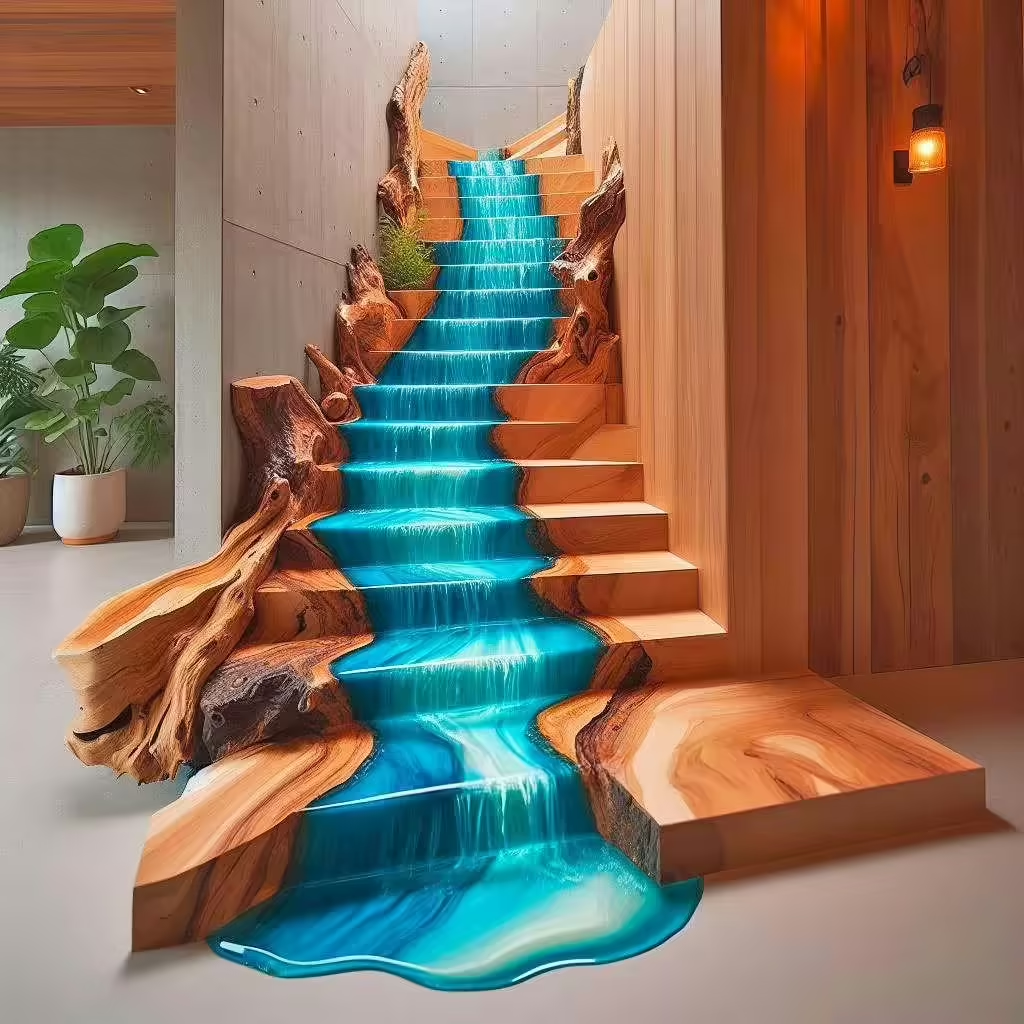In recent years, home design trends have shifted toward unique and personalized elements that not only enhance the aesthetic appeal but also provide functionality. One of the most innovative and striking trends is the use of epoxy river stairs. Combining the natural beauty of wood with the mesmerizing allure of epoxy resin, these stairs create a stunning focal point in any home. In this article, we’ll delve into what epoxy river stairs are, how to design and install them, and the benefits they offer.
What Are Epoxy River Stairs?
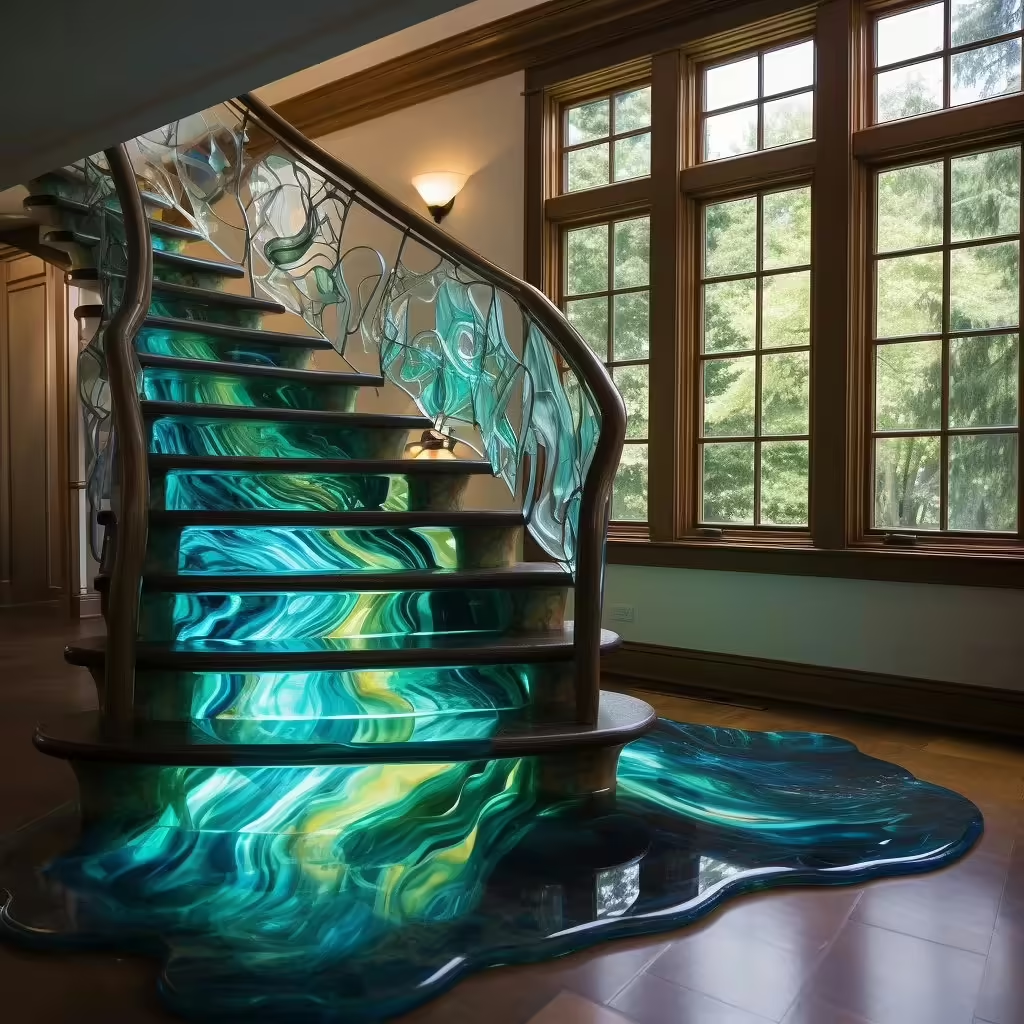
Understanding Epoxy Resin
Epoxy resin is a type of polymer material that is made up of two main components: resin and hardener. When mixed, these components create a durable, water-resistant, and clear substance that can be tinted with various colors. This versatility makes epoxy ideal for a range of applications, including flooring, countertops, and, of course, stairs.
The Concept of River Tables
The river table phenomenon has taken the design world by storm, showcasing the beauty of nature through the combination of wood and resin. Epoxy river stairs take this concept a step further by integrating these elements into a functional piece of home decor. The result is a staircase that resembles a flowing river, with wood grains and colors beautifully highlighted by the glossy epoxy finish.
Benefits of Epoxy River Stairs

Unique Aesthetic Appeal
One of the primary reasons homeowners are drawn to epoxy river stairs is their unique aesthetic appeal. The combination of natural wood and epoxy creates a striking contrast that can enhance the overall design of your home. Whether you prefer a rustic look or a modern vibe, epoxy river stairs can be customized to suit your taste.
Durability and Longevity
Epoxy resin is known for its durability. When properly installed, epoxy river stairs can withstand heavy foot traffic without showing signs of wear and tear. The waterproof nature of epoxy also protects the underlying wood from moisture, preventing warping and decay.
Easy Maintenance
Maintaining epoxy river stairs is relatively easy. A simple cleaning routine involving a damp cloth and mild detergent can keep your stairs looking pristine. Additionally, the smooth surface of epoxy resists staining and dirt buildup, making it an ideal choice for busy households.
Designing Your Epoxy River Stairs
Choosing the Right Materials
Selecting Wood Types
The choice of wood plays a crucial role in the final look of your epoxy river stairs. Different woods offer varying grains, colors, and textures. Some popular options include:
- Walnut: Known for its rich color and beautiful grain patterns, walnut adds a touch of luxury.
- Maple: A lighter wood that provides a clean and modern look.
- Oak: Offers durability and a classic aesthetic, making it a favorite for many homeowners.
Color Options for Epoxy
Epoxy resin can be tinted in a variety of colors, allowing you to customize your stairs to fit your home’s decor. Consider the following options:
- Transparent Epoxy: Showcases the natural beauty of the wood grain while providing a glossy finish.
- Colored Epoxy: Choose bold colors to create a dramatic effect or subtle tones for a more understated look.
Step Design Ideas
Single River Design
The single river design features a straight epoxy flow down the center of each step. This design is simple yet elegant, allowing the natural beauty of the wood to shine through.
Double River Design
For a more dramatic effect, consider a double river design. This features two epoxy flows on either side of the steps, creating a balanced and symmetrical appearance.
Geometric Patterns
If you’re looking to make a bold statement, geometric patterns can add an artistic touch to your epoxy river stairs. Consider integrating angles, curves, or even abstract shapes to create a one-of-a-kind staircase.
Installation Process for Epoxy River Stairs
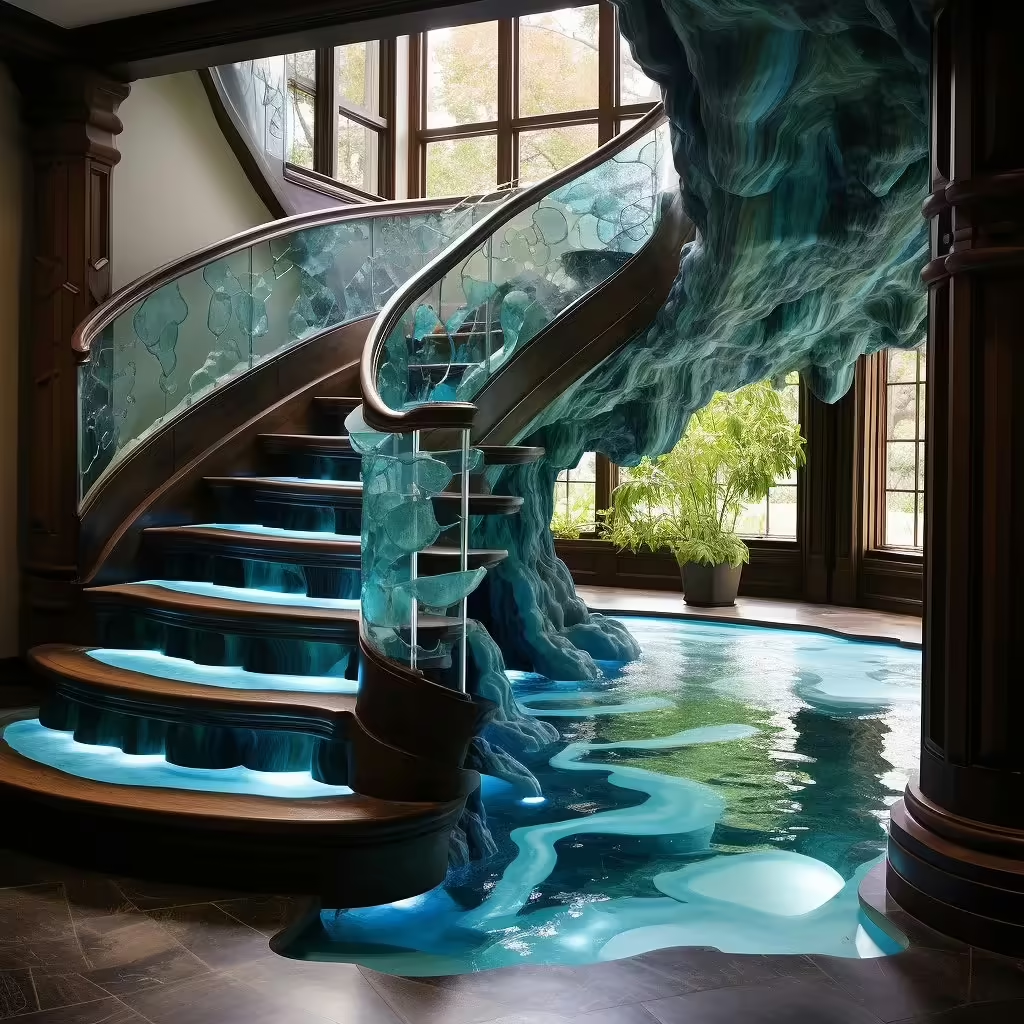
Tools and Materials Needed
Before starting your project, gather the necessary tools and materials, including:
- Epoxy resin kit: Ensure you have enough resin for the entire staircase.
- Wood: Choose your preferred type of wood for the steps.
- Sandpaper: For smoothing the wood surface.
- Measuring tools: To ensure accurate dimensions.
- Protective gear: Gloves, goggles, and a mask to ensure safety during installation.
Step-by-Step Installation Guide
Step 1: Prepare the Wood
Start by sanding the wood to create a smooth surface for the epoxy. This will help the resin adhere better and result in a flawless finish.
Step 2: Create a Mold
Use plywood to create a mold for your stairs. This will help contain the epoxy during the curing process and shape it correctly.
Step 3: Mix the Epoxy
Follow the instructions provided with your epoxy resin kit to mix the resin and hardener thoroughly. If you’re using tinted epoxy, add the color during this step.
Step 4: Pour the Epoxy
Carefully pour the epoxy into the mold, ensuring it fills any gaps and covers the wood entirely. Use a stir stick to help eliminate any air bubbles that may form.
Step 5: Cure the Epoxy
Allow the epoxy to cure according to the manufacturer’s instructions. This usually takes 24 to 48 hours.
Step 6: Finish the Steps
Once the epoxy has cured, remove the stairs from the mold and sand the edges for a smooth finish. If desired, apply a topcoat for added protection.
Maintenance Tips for Epoxy River Stairs
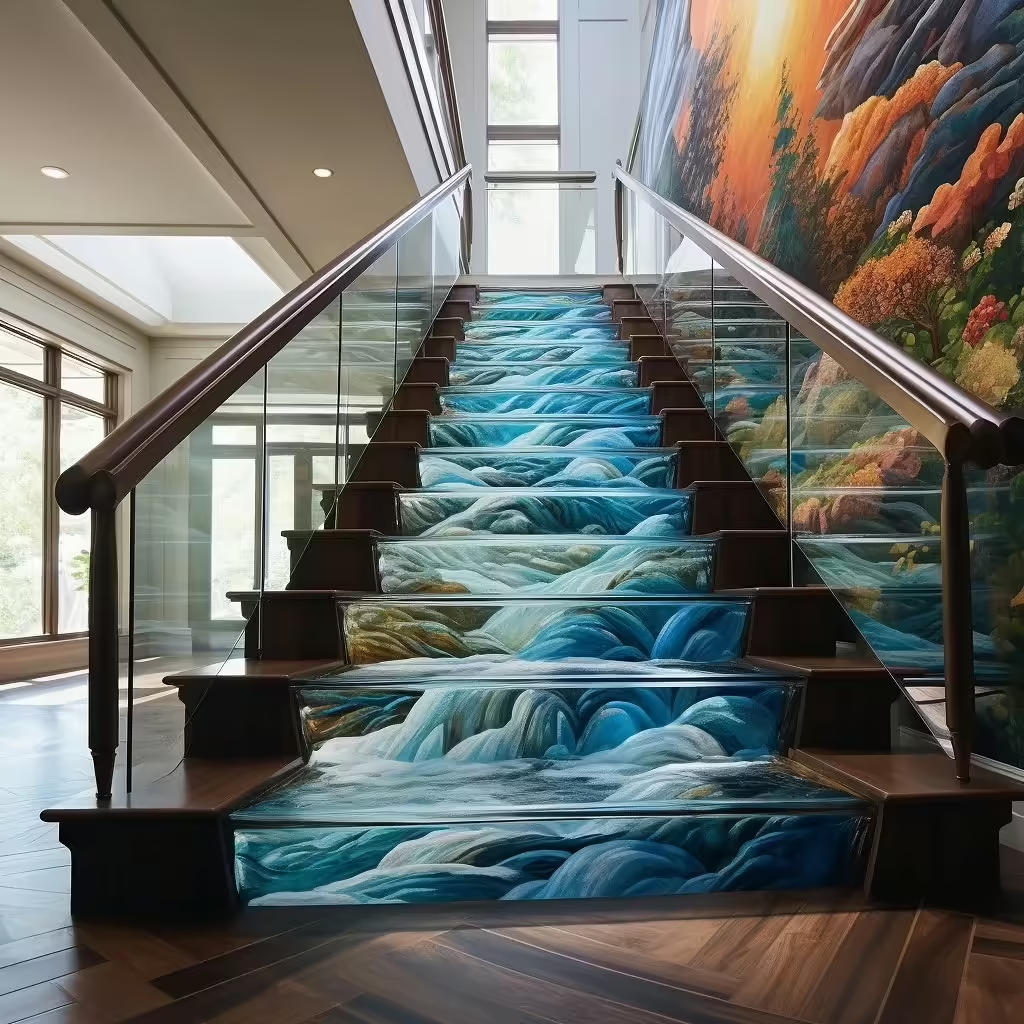
Regular Cleaning
To keep your epoxy river stairs looking their best, incorporate regular cleaning into your routine. Wipe down the steps with a damp cloth and mild detergent to remove dirt and dust.
Avoid Harsh Chemicals
While epoxy is resistant to many substances, it’s essential to avoid harsh chemicals or abrasive cleaners that could damage the surface.
Inspect for Damage
Periodically check your stairs for any signs of damage or wear. Address any issues promptly to prevent further deterioration.
Cost Considerations
Factors Affecting Cost
The cost of installing epoxy river stairs can vary based on several factors, including:
- Material Selection: The type of wood and epoxy can impact the overall cost.
- Design Complexity: More intricate designs may require additional materials and labor.
- Labor Costs: If you hire a professional, labor costs can significantly influence the total expense.
Budgeting for Your Project
When budgeting for your epoxy river stairs, consider all aspects of the project, including materials, tools, and labor. Setting a realistic budget can help you avoid overspending and ensure a successful installation.
Links to purchase similar products: Click here
Expanding on Design Ideas for Epoxy River Stairs
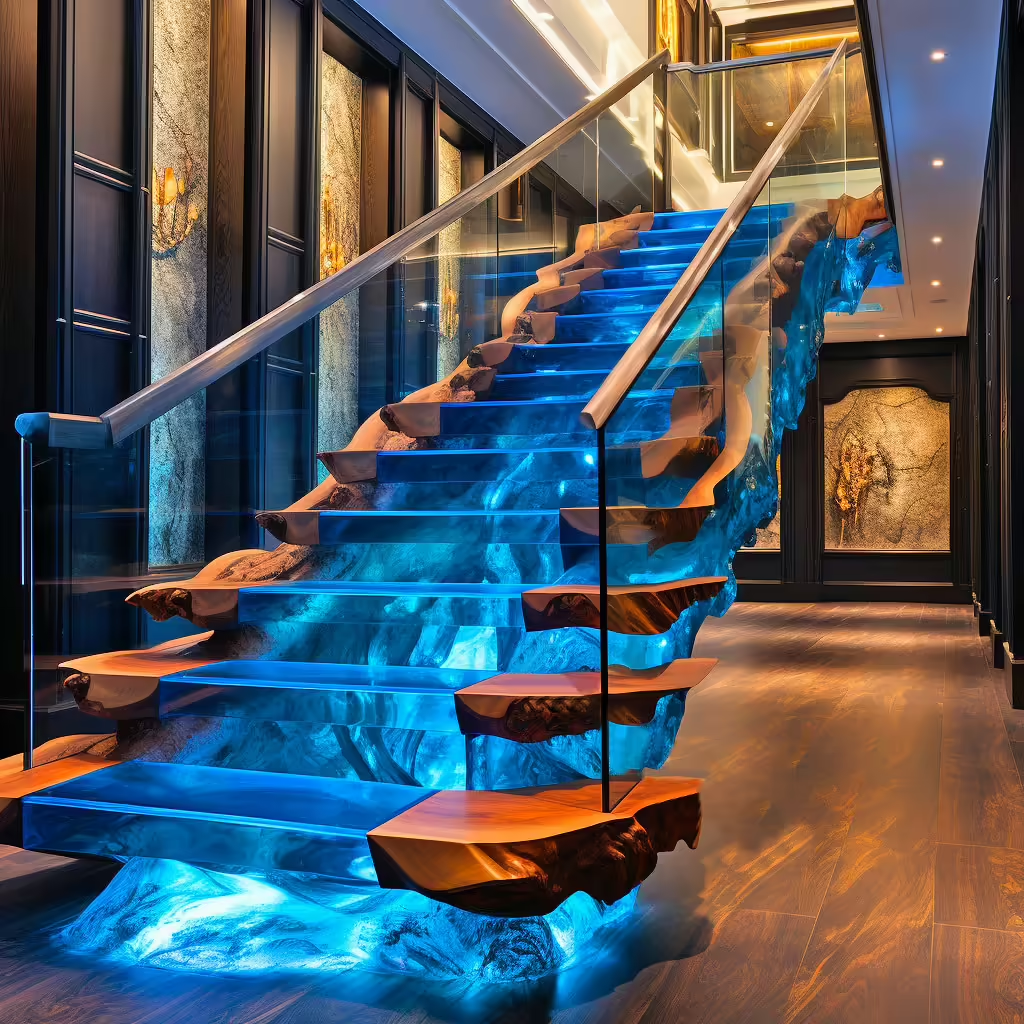
Combining Epoxy with Other Materials
Metal Accents
Integrating metal elements, such as railings or support beams, can create a stunning contrast against the natural wood and glossy epoxy. This combination can enhance the modern aesthetic while ensuring durability and safety. Consider using:
- Steel railings: Sleek and industrial, they add a contemporary touch.
- Brass fittings: For a warm, vintage feel, brass can create an inviting atmosphere.
Glass Panels
For a sophisticated look, incorporating glass panels as part of your staircase design can provide an airy feel. Glass can enhance the visibility of the epoxy river, making the entire staircase appear more open.
- Clear Glass: Offers an unobstructed view of the epoxy river while ensuring safety.
- Frosted Glass: Adds a touch of elegance and can diffuse light beautifully.
Integrating Lighting
Understair Lighting
Adding LED lights under the stairs can create a magical ambiance. This lighting not only highlights the epoxy river but also enhances safety by illuminating each step, especially in low-light conditions.
Backlit Epoxy
For a more dramatic effect, consider using backlit epoxy. This involves incorporating lights behind or beneath the epoxy layer, creating a stunning glow that emphasizes the flowing design of the river.
Themed Designs
Nature-Inspired
Create a nature-themed staircase by incorporating natural elements like stones or dried flowers within the epoxy. This adds a unique touch and can bring a piece of the outdoors into your home.
Artistic Expressions
Epoxy allows for creativity, so why not consider an artistic design? Custom patterns, colors, or even images embedded in the epoxy can transform your staircase into a work of art.
Alternative Applications of Epoxy Resin
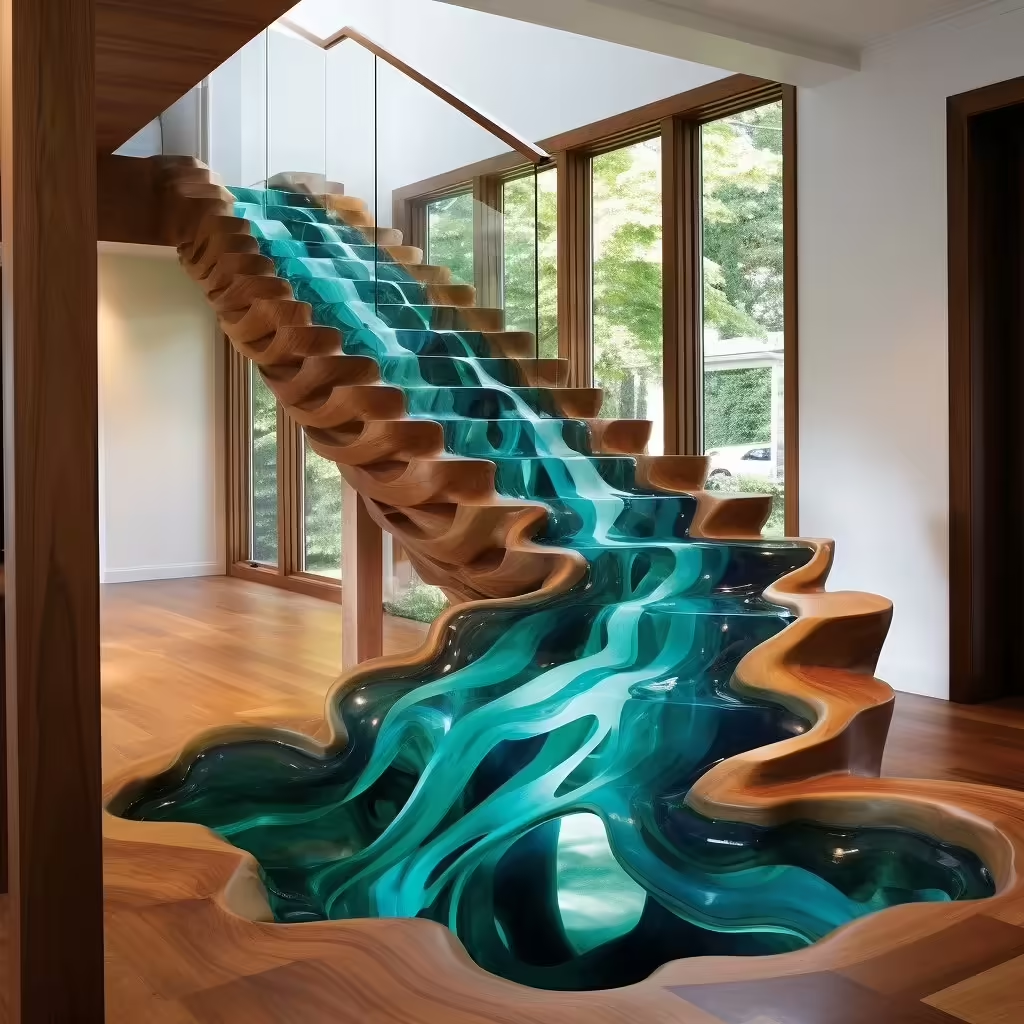
Beyond Stairs: Other Uses of Epoxy
While epoxy river stairs are stunning, the versatility of epoxy resin makes it suitable for various applications throughout your home.
Countertops
Epoxy resin can create beautiful, durable countertops. Like stairs, they can feature embedded designs, colors, and patterns, providing a cohesive look throughout your kitchen or bathroom.
Flooring
Epoxy flooring is a popular choice for homes and businesses alike. It is durable, easy to maintain, and can be customized to mimic the look of natural materials like wood or stone.
Furniture
Custom furniture pieces, such as tables or benches, can feature epoxy river designs. This unique touch can make ordinary furniture extraordinary, elevating your home’s decor.
Comparing Epoxy River Stairs with Other Stair Materials
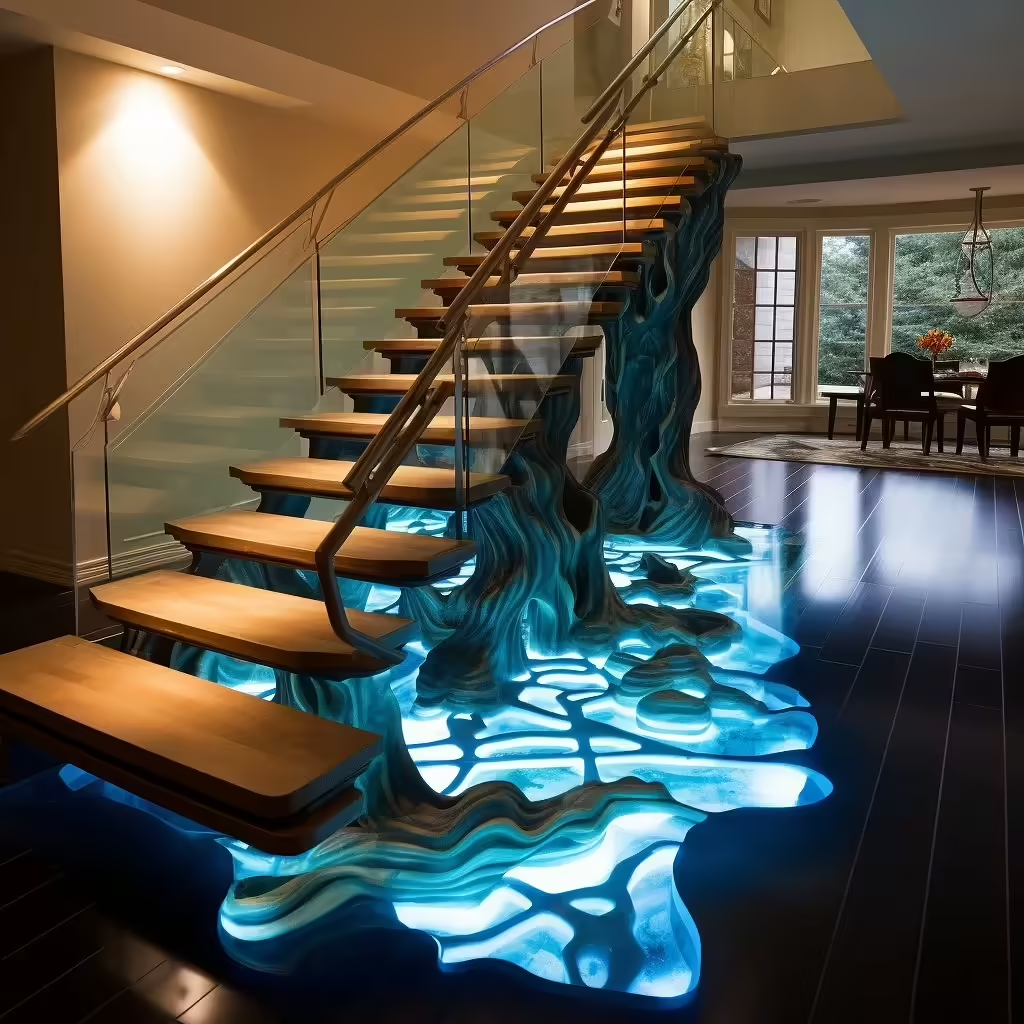
Wood vs. Epoxy River Stairs
While traditional wood stairs are classic and timeless, they can lack the unique flair of epoxy river stairs. Here’s a comparison:
- Aesthetic Appeal: Epoxy river stairs offer a contemporary look, while wood can appear more traditional.
- Maintenance: Wood requires regular sealing and polishing, whereas epoxy is more resistant to damage and easier to clean.
- Durability: Epoxy is less prone to scratches and dents compared to wood, making it a better option for high-traffic areas.
Concrete vs. Epoxy River Stairs
Concrete stairs are durable but often lack warmth and character. In contrast:
- Aesthetic Variety: Epoxy river stairs provide endless design possibilities, while concrete is generally more utilitarian.
- Comfort: Epoxy stairs are typically more comfortable to walk on, especially if designed with contours and textures.
Tile vs. Epoxy River Stairs
Tile is a common material for stairs, particularly in wet areas. However, it has its drawbacks:
- Cold Surface: Tiles can be cold underfoot, while epoxy can be made with a warmer feel.
- Slippery: Epoxy stairs can be textured to prevent slipping, whereas tiles may require additional treatments to enhance grip.
Environmental Considerations for Epoxy River Stairs
Eco-Friendly Epoxy Options
As sustainability becomes more significant in home design, many homeowners are concerned about the environmental impact of materials like epoxy. While traditional epoxy resins are derived from petrochemicals, there are now eco-friendly epoxy options available that minimize environmental impact. Look for:
- Bio-based Epoxy: Made partially from renewable resources, bio-based epoxy reduces reliance on fossil fuels and can have a lower carbon footprint.
- Low-VOC Epoxy: Volatile organic compounds (VOCs) are harmful to indoor air quality, but low-VOC epoxy options release fewer chemicals, making them safer for your home environment.
Responsible Wood Sourcing
Since wood is a significant component of epoxy river stairs, choosing sustainably sourced wood is another way to reduce the environmental impact of your project. Look for FSC-certified wood (Forest Stewardship Council) or reclaimed wood, which reuses materials and reduces the demand for new lumber.
Links to purchase similar products: Click here
Advanced Customizations for Epoxy River Stairs
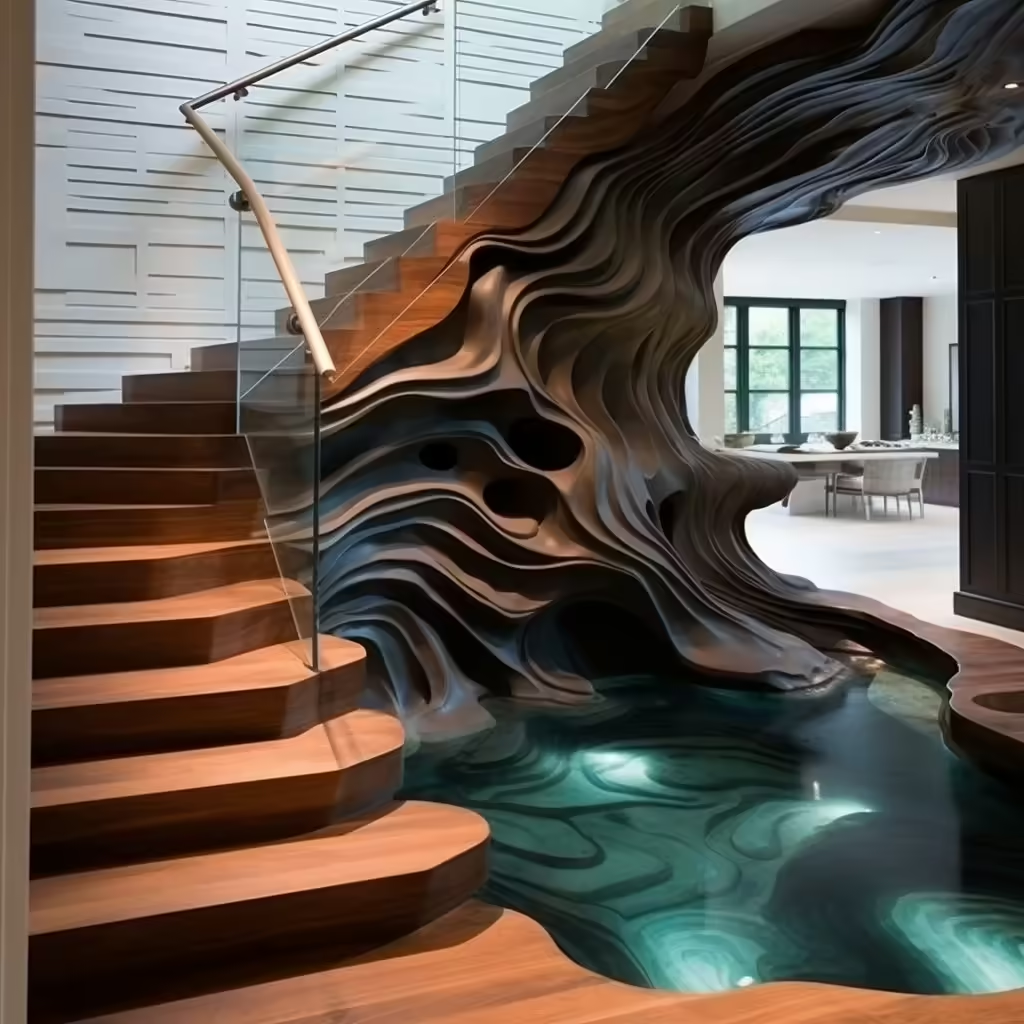
Embedding Elements in Epoxy
One of the fascinating aspects of epoxy resin is its ability to encapsulate objects, allowing for endless creative possibilities. Adding natural elements or personal mementos can make your epoxy river stairs truly unique.
Natural Elements
You can embed stones, shells, leaves, or flowers into the epoxy to give your staircase a natural, organic feel. These elements add texture and depth, making each step a miniature work of art.
Glow-in-the-Dark Pigments
For a touch of whimsy and added safety at night, consider using glow-in-the-dark pigments in your epoxy mix. This option is especially appealing for families or anyone looking to create a dynamic, night-lit effect in their staircase.
Layered Epoxy for 3D Effects
Creating layered designs within the epoxy resin allows for a 3D effect, making the “river” appear as if it’s flowing over stones or sand. This technique requires multiple pours and a steady hand but results in a breathtaking, almost lifelike river appearance.
Conclusion
Epoxy river stairs are more than just a home feature; they are a creative expression of style and innovation. Their unique aesthetic appeal, combined with durability and easy maintenance, makes them an excellent choice for homeowners looking to enhance their living spaces.
By incorporating various design elements—such as metal accents, lighting, and customized patterns—you can create a staircase that perfectly reflects your personality and complements your home’s interior. As you embark on this design journey, remember to consider all your options, including alternative applications for epoxy, and weigh them against other materials for a well-rounded decision.
In the world of home design, epoxy river stairs stand out as a trend that blends beauty, functionality, and artistic expression. Whether you’re renovating an existing staircase or starting from scratch, this innovative design choice is sure to impress and inspire. So, roll up your sleeves, unleash your creativity, and take your home’s interior to the next level with stunning epoxy river stairs.

